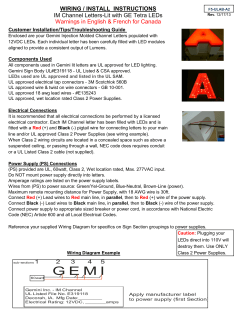
Create an LED Circuit in Minutes
Create an LED Circuit in Minutes National Semiconductor and Avnet Make Design Easier By Jeff Perry, National Semiconductor, Senior Manager, WEBENCH Group Spurred by the increasing cost of energy and concerns about climate change, governments and industry are pushing for higher efficiency lighting. LEDs provide an excellent solution due to their high efficiency and long lifetime. At the same time, LED technology is undergoing a period of rapid change and innovation, with ever brighter and more efficient parts being introduced, and this makes it difficult for the average engineer to keep up with the latest products. Fortunately, online tools for LED selection and implementation make choosing an LED and LED driver easier. But even with these tools, the user should have an understanding of the parameters affecting LED selection. LED Selection The first step is choosing a color for the LED. Colored LEDs are characterized by their dominant wavelength and are available in wavelengths from UV to infrared. White LEDs are specified by their color temperature with warm white LEDs, often used for room lighting, in the 2800K to 3500K range. This compares to an ordinary Tungsten filament light bulb at about 3000K. Also available are cool white LEDs in the 6300K to 7500K area and white LEDs in the middle range of 3600K to 6200K. How Bright Should It Be? Luminous flux, in units of lumens, is the measurement normally used for the brightness of LEDs. This is the amount of light emitted in the spectrum to which the human eye is sensitive. Table 1 shows typical luminous flux values for some light sources: Type 40W Tungsten bulb 100W Tungsten bulb 25W Compact fluorescent 55W Halogen auto headlight 35W HID auto headlight 150W Projector bulb 180W Low-pressure sodium street lamp Lumens 500 1500 1500 1500 3250 5000 27,000 Table 1: Typical Luminous Flux Values for Light Sources Individual high-brightness LEDs typically have luminous flux values of less than 100 lumens, although this is climbing rapidly. LEDs are typically combined into arrays to achieve higher brightness values. Multiple LEDs can be arrayed in parallel strings using one current control driver, but this can lead to differences in brightness in the strings due to the variance in the LED forward voltage and thus current in each string. Therefore, it is preferable to use LEDs in a series for consistent brightness and color. However, the series voltage gets higher with more LEDs, which affects which driver topology can be used – buck vs. boost. Also keep in mind that LEDs are directional in nature. This is specified by the viewing angle, which is the point at which the brightness falls off to 50% intensity. In directional applications, the actual brightness perceived will be higher than a point source of light with a spherical emission pattern, or conversely, if a spherical emission pattern is desired, the array must be designed accordingly. Optics can be used to diffuse or focus the light. A measure of lighting elements efficiency is luminous efficacy, which has units of lumens/watt. With the explosion of LED R&D, parts with values of 75lumens/watt are readily available and LEDs with 115 lumens/watt have been recently introduced. This compares with tungsten filament bulbs at about 17 lumens/watt, CFLs at 60 lumens/watt, and low pressure sodium street lamps at 100 to 200 lumens/watt. Figure 1 has a table of LEDs with a graph of the luminous flux vs. power showing a range of efficiencies for various LEDs. Figure 1: LED Selection Showing Graph of LED Luminous Flux vs. Power Voltage and Current The forward voltage of an LED is a characteristic of the process used to manufacture the LED with yellow/orange/red LEDs in the 2-3V range and blue/green/white LEDs in the 3-4V range. The current through the LED controls the brightness and affects the color. Therefore, LEDs are run in a constant current mode. High-brightness LEDs typically come in currents of .35A, 0.7A, 1.0A, 1.4A, and up. Also to be considered is the footprint and height of the LED. Provision must also be made for heat sinking, which becomes vital in highcurrent applications. Cost, is of course, another critical parameter. LED Selection Made Easy LED selection has been made much easier with the introduction of online selection tools from National Semiconductor and Avnet. The ability to do a sideby-side comparison of multiple solutions along with graphical analysis provides the user with unprecedented power to rapidly get to the best solution. Temperature Control for LEDs Why do we need temperature control and monitoring for LEDs if they are supposed to be so efficient? Don’t LEDs run cooler than incandescent light sources? It turns out that while LEDs are much more efficient than tungsten filament bulbs, they still generate a lot of heat. Incandescent lights generate heat which largely leaves the system as infrared radiation. On the other hand, LEDs generate heat in the diode semiconductor structure in addition to photons. This heat is not part of the radiated spectrum and it must exit the system through conduction and convection. If LEDs are allowed to get hot, a number of issues arise. The brightness of LEDs goes down markedly with temperature. Also, the color of LEDs changes with temperature, which can lead to problems in applications that require consistent color integrity such as RGB-generated white light. Electrical characteristics, such as the forward voltage of the LEDs, will drift with temperature which may have to be taken into account when designing the driver circuitry. This change can also be an issue if the LEDs share current in parallel configurations. Constant exposure to high junction temperatures accelerates the degradation of LEDs and reduces their life and reliability. Thus, it is essential to design the system so it runs within the temperature specification of the LEDs. This is normally accomplished using heat sinks, such as large copper areas on the printed circuit board, attached fin heat sinks, and/or thermally-enhanced/metal PCBs to mount the LEDs. Forced airflow can also be used. However, if an unusual event occurs, such as extraordinary weather-related heat or failure of a heat sink, a failsafe mechanism can be implemented. Most buck topology LED drivers have thermal shutdown, so if the drivers exceed a specified temperature, typically 125C to 150C, they will turn off along with the LED. Boost topology drivers will protect themselves, but not the load when they shut down so they require a crowbar circuit or other protection for LEDs. In any case, the LED temperature may be higher than the driver, and the LEDs thus require their own temperature sensor and monitoring circuit for failsafe protection. This temperature sensor circuit can either reduce/turn off the current to the LEDs, turn on a cooling fan, and/or provide an alert mechanism to the user or maintenance personnel. Types of Temperature Sensors for LEDs In general, temperature sensor accuracy needs to provide enough margin to be able to both detect an over temperature problem and at the same time not trigger a false alarm under normal operating temperatures. For example, if a system is normally operating at up to 80C, and it is desired to detect a fault condition at no more than 100C, a temperature sensor system with +/- 2C accuracy set to trip at 98C should be fine, but one with +/-10C accuracy set to trip at 90C would be marginal. Discrete temperature sensors appropriate for LEDs include thermistors which change resistance as the temperature changes. Thermistors are inexpensive and have high sensitivity, but are non linear, thus requiring initial calibration. Thermistors are available in the desired temperature range of 50C to 150C. Another choice is thermocouples. The voltage of these sensors changes as the temperature changes and they also generate a current so they don’t necessarily require a power source. They are less sensitive than thermistors, but are good enough for LED use. They come in a wide range of temperatures, well beyond what is required for LEDs and are used widely in other applications. The cost is high relative to thermistors. Both of these sensors require some analog circuitry either to interface with a microcontroller which can then take action to correct the temperature problem or to interface directly to the LED driver via a shutdown or dimming pin. Silicon temperature sensors, which come in temperature ranges of -50C to 150C, may also be used for LED applications. These inexpensive sensors provide a wide variety of options ranging from analog voltage output which is proportional to temperature, temperature triggered on/off output with hysteresis, fan control, and digital interfaces such as I2C and SPI/ Microwire to interface with a microcontroller. Temperature Sensor Application Example A simple circuit for interfacing an LM26LV temperature sensor directly to an LM3404HV buck LED driver is shown in figure 1. The temperature sensor should be placed as close as possible to the LEDs. In this circuit, the OVERTEMP pin of the LM26LV is normally high when the temperature is below the specified value, but the pin goes low when the temperature is high, thus shutting off the LM3404HV via the dim pin. When the temperature goes back 5C below the specified value (the sensor has a hysteresis feature), then the OVERTEMP pin goes high and the LM3404HV will turn back on. Figure 2: LM26LV Silicon Temperature Sensor with LM3404 LED Driver A simple temperature sensor can be used to monitor and correct for over temperature situations in LED applications. More sophisticated systems can be implemented which proportionally reduce current to the LEDs without shutting them down as the LED temperature rises above a threshold. Or a fan can be turned on (and RPM increased) after the LED temperature exceeds the specification. None of these systems are a substitute for good thermal design for the LEDs, but they can be used as a failsafe shutdown to enhance LED life and reliability when the normal thermal controls fail.
© Copyright 2025











